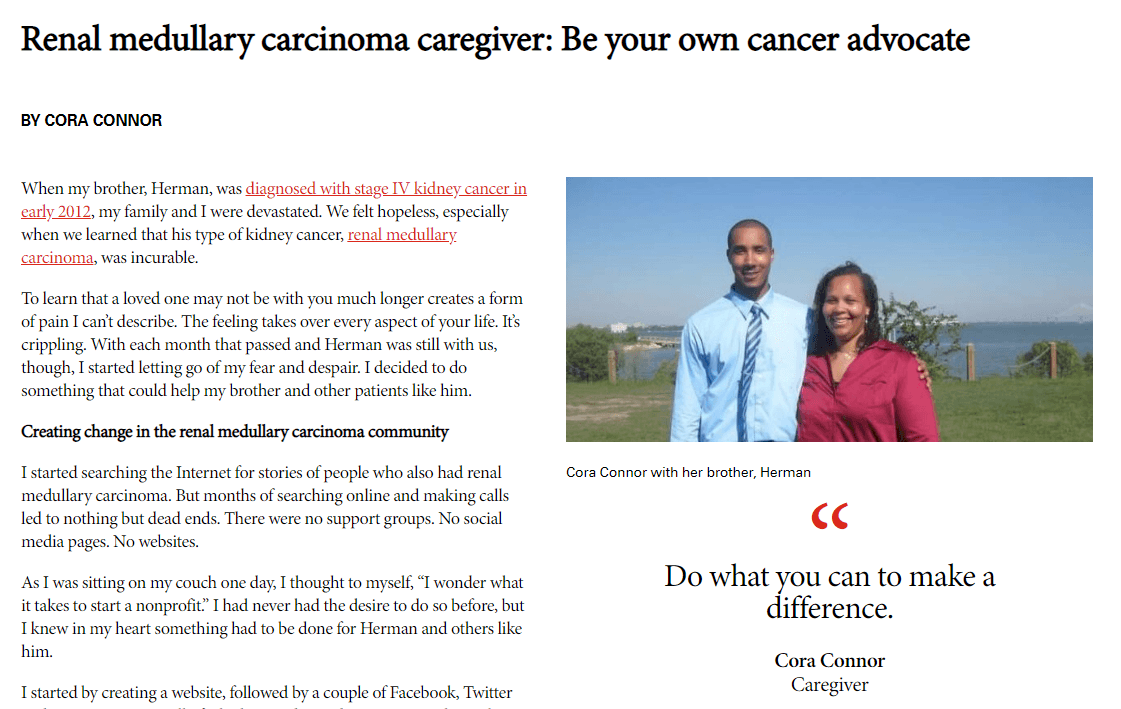By harnessing the influence of patients, you’ll better reach your audiences and publish content more quickly and easily.
Content marketing — the strategy, the stakeholders, the editorial calendar planning, and the posting — can seem daunting. On top of all the other tasks in a marketer’s day, writing articles or shooting videos about stories inside the health system might lose priority.
Add to that stress a lack of internal resources or changing priorities, and it can be hard to finish the content you’d committed to create only a month ago.
That’s why patient stories – authored by real patients – can help relieve the tension and give your content marketing a new, authentic voice and perspective.
Benefits of Using Patient-Generated Content
A 2011 article in the New York Times cited “narrative communication” – or storytelling – as an effective way to help patients improve their health. That means when patients share stories, health outcomes can improve.
“Telling and listening to stories is the way we make sense of our lives,” according to Dr. Thomas K. Houston, who’s quoted in the article. He adds that storytelling can help readers accept a difficult diagnosis if they identify with a storyteller with the same condition.
Aside from the benefit it delivers to your audiences, storytelling also has the power to continue encouraging innovation and growth in service lines based on what patients say is working best.
For the storyteller, the opportunity to share a story can be relieving and therapeutic, especially if they care deeply about helping others in their shoes. The diversity of experiences also helps highlight your organization’s reach and focus on quality patient care.
Invite Patient Voices to Your Brand
While content marketing in healthcare is often – and rightly – focused on tips to help your patients and community members get well and stay healthy, don’t miss opportunities to bring patient voices into your online brand experience.
Consider inviting your patients to get involved in your content marketing by:
- Putting a call to action on social media. Ask your followers if they have a story about being a patient or family member of a patient of your organization. What’s the experience they’d like to share? Give them a direct way to contact you and share their story.
- Asking your patient and family advisory council, or PFAC, if you have one. These groups can provide insight into how people see your organization outside your walls. If you don’t have a PFAC, consider creating one.
- Letting patients opt to share their story via existing surveys and feedback processes. If you have a patient feedback process, let them know that you invite patient voices to be part of your content marketing experience.
- Using your website to generate story leads. If you have a content marketing hub today – or even if you don’t! – create an online form and appropriate call to action where people can submit their experience and volunteer to author a story. Check out how Bronson uses their Bronson Positivity microsite to get stories from patients, visitors, and caregivers.
Examples of Patient Stories
See how some healthcare systems apply the patient content strategy in their content marketing efforts.
MD Anderson Cancer Center
MD Anderson’s Cancer Center’s editorial brand Cancerwise shares its space with caregivers, too. Cora Connor is a caregiver for her brother, Herman, diagnosed with a rare cancer. In her two-part story, she shares not only her story of caregiving, but also of creating a community and becoming an advocate for people diagnosed with the same cancer as Herman.
Cora’s article adheres to the consistent voice and tone of MD Anderson’s brand, even though she’s not a member of the marketing team. Helpful cross-links to Herman’s doctor’s profile and other related content are available throughout the story. It even links to Cora’s previous story about being a loved one of cancer patient.

Cone Health Engages with Video Patient Stories
In Cone Health’s content marketing hub, Wellness Matters, patient Kimberley Thompson-Hairston shares her bariatric surgery journey and experience via video. The audio is Kimberley in her own words without narration or an interview-like structure typically seen in patient stories.
And Cone Health integrates her story – like the others they share– into the service lines represented. Kimberley’s experience led her to become an advocate for other bariatric surgery patients at Cone Health.
Your Staff Are Patients, Too
As you build your brand ambassadors and storytellers, look inside your organization, too. Your staff are patients, parents, caregivers, and loved ones of other patients, so why not explore their stories, too?
Avera Balance features articles from patients and staff writers alike, including Sonja Hegman, a contributing writer who shared her story about treating her cancer without traditional cancer treatments like chemotherapy and radiation.
Her story is heartfelt: She explains the questions she received after diagnosis, and the curiousness of people around her who wondered why she hadn’t lost her hair if she had cancer, even writing that she sometimes “felt guilty for not having enough cancer.”
Establish a Strategy & Workflow for Contributors
Before you send out a blanket invitation for articles from your patient community, make sure your marketing team’s content marketing strategy has a defined goal. For example, you’ll want to ask yourselves:
- How often should patient stories be included in the editorial calendar?
- What service lines do we want to grow volume for, and how could patient stories help?
- What’s the workflow for editing patient-generated content and making revisions?
While your marketing team writers would likely follow a brand style, voice, and tone guide, your patient audience may not be as privy to this experience. But, guiding them with high-level recommendations for how to write their story, what to share, etc. may be helpful.
You may also consider informing your contributors up-front about any edits and adjustments you’ll make to the final product. Subheads, images, and paragraph breaks — along with standard proofreading and editing — should be part of the agreement.
A patient-generated story template might also be a good way to set the stage for your expectations from patient contributors.
While inviting outside writers to your organization’s content marketing efforts might feel like another layer of governance, it can be a very rewarding experience for your brand. If you need help setting expectations, governance, and work flows for your team, contact Geonetric.
Be Transparent & Honest With Storytellers
Whether you’re engaging patients, family members, or staff to share their story, be up-front about your expectations and editorial process.
Consider creating a checklist to ensure the storyteller understands the process and knows what happens next. For example:
- Get written permission from the storyteller to share the story on your website, content marketing hub, social media, and beyond.
- Identify and communicate the goals and purpose of their story, how it will be shared, and what they can expect after publication (e.g. local press, social media followers, etc.). Be willing to support them post-publication if needed.
- Set expectations for process and timeline, including first drafts, revisions, proofreading, and final review before publication.
- Stay transparent through the process, including when you’re nearing publication. Ease anxieties by helping your storyteller understand the editing process, or giving a glimpse of how the article will look when it’s published.
Celebrate Your Brand Ambassadors
As a team member and employee of your health system, you no doubt represent your brand in public and online. But your organization’s patients, their loved ones, caregivers, and friends are just as much a part of your organization’s story. By including them in your storytelling and sharing their voice and experiences with your readers and audiences, you’ll connect with people who need guidance most.
Reach Out
If you need help getting started with your content marketing strategy, contact Geonetric. Our experts can help you find a content marketing model that fits your organization and resources and paves a way for brand wins.
